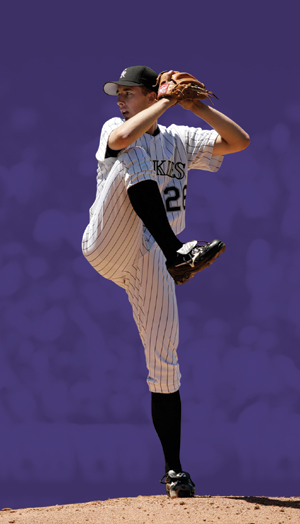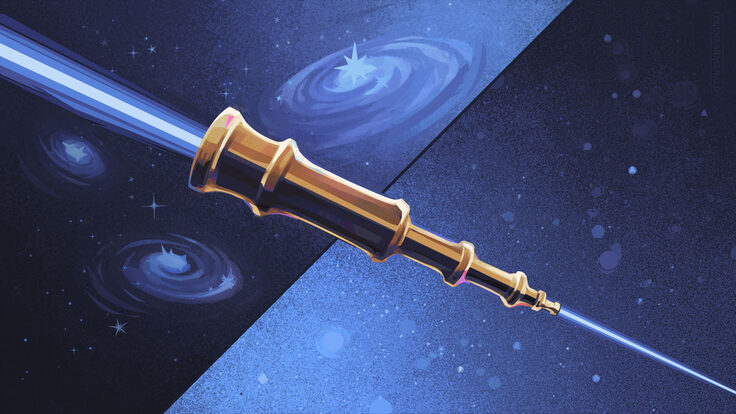A magnus force on the mound
Major league pitcher Jeff Francis brings an educated insight to the physics of baseball.
by Mike Perricone
 |
|
Photo courtesy of Major League Baseball |
The Magnus force has made Jeff Francis what he is today: a 25-year-old left-handed pitcher on the rise in his second full season with Major League Baseball's Colorado Rockies.
A former physics and astronomy major at the University of British Columbia, Francis could hold court for the Rockies' pitching staff and coaches to discuss the Magnus force and its deviational effects on the path of a 5.25-ounce baseball spinning through the air with a forward velocity of more than 90 miles per hour (or more than 132 feet per second), over a distance of 60 feet, six inches. Francis could clarify what puts the curve in a curveball, the "hop" in a fastball, the slide in a slider, the sink in a sinker.
But he won't be giving that talk any time soon.
"As much as it might seem contradictory," Francis says, "physics knowledge does not help much on the field. So much of playing baseball is 'feel' that explaining to someone what makes a ball curve would be almost meaningless. I get asked that a lot, and sometimes I say: 'I never met him, but I bet Einstein couldn't throw a curveball.'"
On the other hand, Einstein did toss a memorable and gigantic curve at physicists' concepts of matter, space, and time a hundred years ago. Francis is good, but he hasn't yet matched that impact.
At six feet, five inches tall and 200 pounds, the Canadian-born Francis would be a dominating presence in physics labs or lecture halls. On a baseball field, however, he is practically willowy. Most major league pitchers of his height (for example, Kerry Wood and Mark Prior of the Chicago Cubs) are 25-to-30 pounds heavier with a consequently more imposing appearance as they stare down at a hitter from the pitcher's mound.
But delivering a pitch is all about physics: the most efficient transfer of momentum from body to baseball; the maximum effectiveness of the arm as a lever; the rotational dynamics of the baseball leaving the fingertips. And within four-tenths of a second after Francis delivers a pitch, the batter faces his own challenge of physics and mechanics.
In The Physics of Baseball, Robert K. Adair (Sterling Professor Emeritus of Physics, Yale University; Official Physicist to baseball's National League, 198789) says a batter must react in less than one-fourth of a second. In the one thousandth of a second of bat-ball contact, Adair says, a superlative hitter such as Albert Pujols of St. Louis will deliver some 8000 pounds of force, compressing the ball to about half its original diameter–that is, if Pujols meets the ball precisely on the bat's "sweet spot," or vibrational node (point of no vibration), after analyzing and reacting to the Magnus force effects on the pitch thrown by Francis.
The Magnus force was identified in 1852 when the German physicist Gustav Magnus demonstrated that a spinning object moving through a fluid experiences a sideways deflection in its path. As Adair explains, a spinning baseball experiences an imbalance of forces because "the velocity through the air of one side of the ball at the spin equator is greater than the velocity of the other side." The resultant force acts at right angles to the direction of the air velocity and to the axis of spin. A twist of the wrist, and a pitch with sideways spin will deflect in the direction of the spin. The sideways-spinning curveball of a left-handed pitcher like Francis breaks from left to right as he watches his own delivery; away from a left-handed batter (advantage, Francis) but toward a right-handed batter (advantage, Pujols).
On a pitch with backspin–the conventional fastball–the Magnus force acts upward; not suf ficient to lift the ball, but sufficient to deliver a perceived "hop" on its way to the plate. Francis once conducted his own inquiry into the question of whether a fastball could actually rise.
"My second-year mechanics professor found out I was a ball player, and asked me to do a presentation with another softball player in the class," Francis recalls. "We read The Physics of Baseball, and one chapter was about the ball's flight toward the plate. The ball rising [is] an optical illusion. Normally, the ball drops a certain amount in the quarter-second or so that it's in the air on its regular flight towards home plate. If the right backspin is obtained, the air can hold it up just a bit longer on the way to home plate, dropping a certain fraction of the regular distance. Since the eye is so used to seeing it drop the regular amount, the ball gives the illusion of rising on the way towards the batter."
Sometimes the hitter will swing under the "hop," but Francis observes that hitters are also intuitive physicists.
"I think all baseball players, whether they're superstars or not, are aware of certain physical aspects of the game by just being around baseball and observing," Francis says. "For example, you'll always see hitters tapping their bat with their hand and then listening to it like a tuning fork, knowing that a higher sound means a higher frequency, which means harder wood, which, in turn, means the ball will jump off the bat more."
Francis says teammates knowing about his physics background often tease him good-naturedly about being an intellectual, although "I can't get any more crossword clues than anyone else." Physics, math, and chemistry came easily to him in high school, leading to his undergraduate major at the University of British Columbia. But baseball took precedence, and he signed his first professional contract with Colorado in 2002. He is regarded as a pitching mainstay on a young team establishing itself as a forceful presence. His head and heart are on the mound, though physics is an active memory.
"I had a great professor [at UBC] named Jaymie Matthews," Francis says, "who taught the classes in such great ways that to this day, I still remember some of his lectures." Asked about a direction he might have taken in science, Francis muses: "At UBC there is a medical physics program, which I was very interested in
Maybe a career in cancer treatment research? I don't know for sure. But I'm happy where I am right now."
Click here to download the pdf version of this article.






